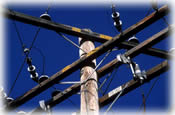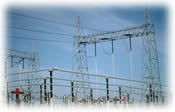
Grades 9-12

Don't have an account yet? Sign up for free
Don't have an account yet? Sign up for free


This lesson focuses on the scarce and nonrenewable nature of fossil fuels in order to stimulate student thinking about energy conservation. It emphasizes the fact that saving energy can be good for the wallet as well as the earth’s future. Students play a memory game that challenges them to find people-powered substitutes for things that use electricity and gas. Students then use the federally-mandated EnergyGuide labels to estimate the cost savings of energy- efficient home appliances. In a final activity, students explore positive and negative economic incentives that motivate people to conserve energy. Many federal energy-related programs and policies are featured in this lesson. These include, besides the Energy Guide label, EnergyStar certification, the Fuel Economy Guide for motor vehicles, and a diverse collection of taxes, tax breaks and subsidies.
In this lesson, students examine options for reducing their dependence on energy resources, especially by substituting people power for other forms of energy and purchasing energy efficient home appliances. Students also explore some of the government programs that are influencing consumer choices in the marketplace.
High energy prices are in the news again! Dwindling supply relative to demand has put the squeeze on oil – increasing prices at the gas pump as well as for home heating fuel. Given that natural gas-fired generators are the source of much of our electricity, the higher price of oil has a ripple effect on electricity bills.
prices at the gas pump as well as for home heating fuel. Given that natural gas-fired generators are the source of much of our electricity, the higher price of oil has a ripple effect on electricity bills.
The August 2003 blackout has brought to the forefront another reason to anticipate higher energy prices. The nation’s electrical transmission system — the high-voltage network that connects the power plants to the local distribution companies that deliver electricity to end users — needs to be updated. Someone will have to pay for this investment in the power grid and ultimately, it will be the consumer.
Higher market prices are serving as an economic incentive for people to reduce energy consumption. Government programs in the form of taxes and subsidies serve as additional incentives for saving energy.
NOTE: If you would prefer to have students use the current rate for a kilowatt of electricity in your community, you will need to research the current rate on a local utility bill or have a copy of a bill available so that students can find the rate on their own.
All activities in this lesson can be completed by students independently, in teams or in small groups.
Activity 1: People Power
 Play the Energy Conservation Game to learn about conserving energy.
Play the Energy Conservation Game to learn about conserving energy.
Reinforce this activity, by having students think of other ways to substitute people power for fossil fuel and electricity. Discuss how these changes would influence their lives in terms of comfort and convenience.
Activity 2: Energy-Efficient Appliances
[NOTE: You may want to print this worksheet in advance and distribute it to the students instead of having them print it during the lesson. If you prefer, you can also direct students to use the current rate for a kilowatt of electricity in your community. Give students the rate or have them find it on a copy of a local utility bill.]
Students may be unfamiliar with the terms top load and front load. Explain that the two washers they are comparing have different designs. Older washers are typically top load in design. Front loaders — this means laundry is put in from the front of the machine versus the top – are relatively new to the U.S. market. Front-loaders work by tumbling the clothes and then spin-drying them in a tub that rotates on a horizontal axis. There are some exceptions. One manufacturer makes a horizontal-axis machine that loads from the top, and another company sells a machine with an axis that is between vertical and horizontal. Front-loaders designs are just as effective in cleaning clothes as top-loaders designs. Some studies report they actually clean clothes better.
Typically, front-loaders use less water: from one-third to one-half the amount that top-loaders require. Because less water is used, less natural gas or electricity is required to heat the water. The machines also spin faster and clothes are wrung out more completely. Not factored into the label estimates is the fact that the improved spin-drying reduces the cost of running a clothes dryer as well.
Horizontal-axis washers (front-loaders) have one major drawback – the initial purchase price is almost always greater than the price for vertical-axis machine (most top loaders). As the worksheet example illustrates, however, the energy savings provided by front-loaders can more than compensate for the higher purchase cost. In some areas of the U.S., utility companies, environmental groups and government agencies help sweeten the deal by offering incentives to consumers who buy front-loaders.
When students have completed their worksheets, discuss:
[NOTE: There are a number of ways to analyze the life cycle cost of appliances. The calculation in this activity illustrates one of the simpler methods. A more complex approach is life-cycle costing which takes into consideration all costs (purchase, installation, operation, maintenance and repair costs) less salvage value – all expressed as present dollar values. For definitions of these terms and the formula for performing life-cycle cost analysis, see the Life-Cycle Costing Manual for the Federal Energy Management Program, Handbook 135.]
Once your students have finished working on their worksheet, have them finish this activity. Use this sample of an Energy Guide for a refrigerator-freezer to answer the questions .Then have them print out their results to hand in. The answers to the questions are below.
Discuss how much it would cost to operate the most efficient refrigerator-freezer for a year. Make sure that students round their answers.
Activity 3: Government Incentives
Have your students complete this activity distinguishing between positive and negative incentives then summarize how these economic incentives influence energy conservation. Discuss the correct answers with your class. View Interactive ActivityIn contrast, a true tax credit is a dollar for dollar reduction in taxes paid. In the tax credit example provided as part of this activity, the taxpayer would first calculate their taxes using an IRS 1040 form. The taxpayer can then reduce the amount of tax he or she pays by the precise amount (within limits) spent on home improvements for energy conservation.
 people conserve just because they think it is the right thing to do. Others are influenced by different economic incentives. Of course, there may also be some students who claim nothing presently motivates them to be an energy saver. If you have some of the latter, point out that there are consequences with this choice. Each dollar used to pay for energy represents a dollar less that can be used to purchase other goods and services they might prefer. Examples from school might be more computers, additional books in the library, painting the cafeteria, and after-school activities. At home, many students would probably prefer more money to be spent on their allowance, a family vacation, a nicer car, etc.]
people conserve just because they think it is the right thing to do. Others are influenced by different economic incentives. Of course, there may also be some students who claim nothing presently motivates them to be an energy saver. If you have some of the latter, point out that there are consequences with this choice. Each dollar used to pay for energy represents a dollar less that can be used to purchase other goods and services they might prefer. Examples from school might be more computers, additional books in the library, painting the cafeteria, and after-school activities. At home, many students would probably prefer more money to be spent on their allowance, a family vacation, a nicer car, etc.]JUST FOR FUN (MORE INFORMATION)
Assessment tools are provided as part of two activities.
The worksheet Using Energy Guides in Activity 2 requires students to use federally-mandated Energy Guides to calculate the cost of operating appliances. Students must also make and support a choice between two washers based on purchase and operating costs.
At the end of Activity 3, students are asked to submit a summary of how positive and negative economic incentives influence consumer behavior with respect to energy conservation.

Grades 9-12

Grades 9-12

Grades 9-12

Grades 9-12
